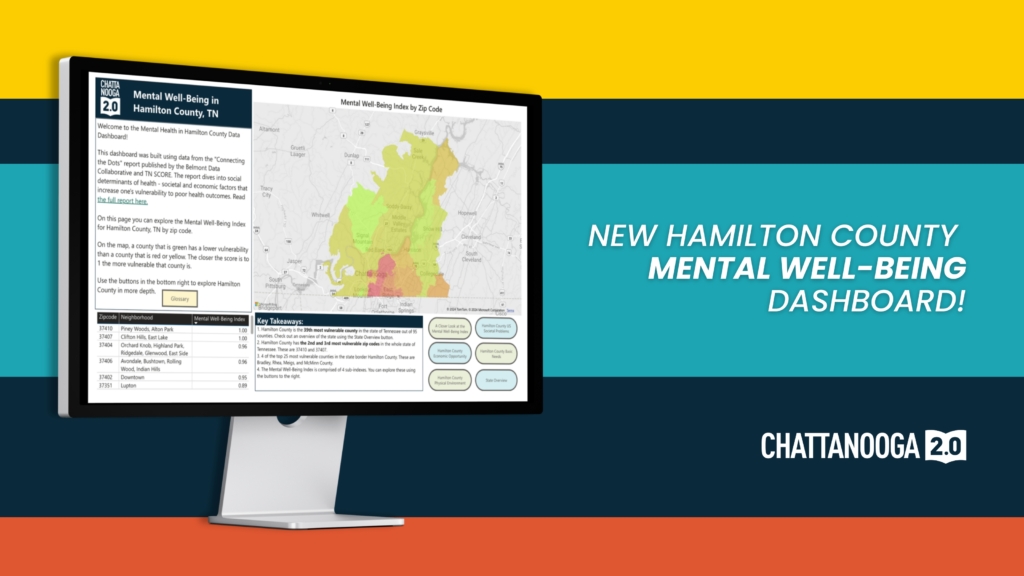Today, Chattanooga 2.0 launches Hamilton County, TN’s first-ever Mental Well-Being dashboard to examine social determinants of health by zip code. This dashboard was built using data from the report “Connecting the Dots – Mental Health and Student Success in Tennessee” published by the Belmont Data Collaborative and TN SCORE. We are grateful for their partnership and support as we work to move this data to action for our community. The full report can be found here. There is a lot of information included in this dashboard, so let’s dig in!
What is the Mental Well-Being Index and why is it important?
The Mental Well-Being Index examines social determinants of health which are societal and economic factors that increase one’s vulnerability to poor health outcomes. By combining data from multiple sources, the index provides a look into mental well-being across zip codes in Hamilton County. Zip code level data is critical for identifying disparities, understanding root causes of mental health challenges, and directing resources to neighborhoods with the greatest need.
How is the Mental Well-Being Index calculated?
The Mental Well-Being Index is comprised of four sub-indices, each addressing different factors of well-being. The sub-indices are made up of a variety of variables which allows for an in-depth view of key aspects affecting well-being. Here is an overview of the sub-indices:
- Highly Detrimental US Society Problems – Measures the prevalence of highly detrimental issues impacting society at large such as total crime index or the percent of disconnected youth.
- Socioeconomic Status & Opportunities for Accruing Wealth – Examines economic conditions, including opportunities for wealth accumulation and economic security.
- Basic Needs (Housing, Food, Transportation, & Health Care) – Addresses access to essential needs that are critical to well-being.
- Physical Environment (Local and Global) – Evaluates factors in the immediate and larger physical environment that impact health.
The dashboard allows you to explore each sub-index by zip code as well as dive into the variables that make up each sub-index. Make sure to check out the glossary to review all the variables and their data sources included in the dashboard.
What does the dashboard tell us about our community?
The Mental Well-Being Index assigns scores from 0 to 1, with higher scores indicating greater vulnerability. Out of the 95 counties in Tennessee, Hamilton County is the 39th most vulnerable with a Mental Well-Being Index of 0.59, indicating moderate vulnerability. Here are the sub-index scores for Hamilton County:
- Basic Needs: Score of 0.89, indicating high vulnerability.
- Physical Environment: Score of .88, indicating high vulnerability.
- Societal Problems: Score of 0.38, reflecting low vulnerability.
- Economic Status: Score of 0.11, the least vulnerable area for the county.
Hamilton County has two zip codes – 37410 (Piney Woods/Alton Park) and 37407 (Clifton Hill/East Lake) – that are the 2nd and 3rd most vulnerable zip codes in the whole state, each with the highest possible score of 1.00. Notably the county also contains five of East Tennessee’s ten most vulnerable zip codes: 37410 (Piney Woods/Alton Park), 37407 (Clifton Hill/East Lake), 37404 (Orchard Knob/Highland Park), 37406 (Avondale/Bushtown), and 37402 (Downtown).
What does it all mean and how can we use this information?
While Hamilton County’s overall vulnerability level is moderate, the risk is not distributed evenly across the county, nor is it distributed evenly across sub-indices. This dashboard allows for targeted action in particular areas such as basic needs and physical environment and in specific zip codes like 37410 and 37407, where vulnerabilities are at critical levels.
Addressing these challenges requires cross-sector collaboration and community-driven solutions. This dashboard is a vital tool for community partners and policymakers to understand and respond to Chattanooga and Hamilton County’s needs, focusing on high-need areas like housing, transportation, and environment. It helps prioritize funding, advocate for policy changes, and support grant applications with robust data. The Mental Well-Being Index highlights intervention needs and measures policy impact over time, enabling partners to build effective strategies for lasting change.





